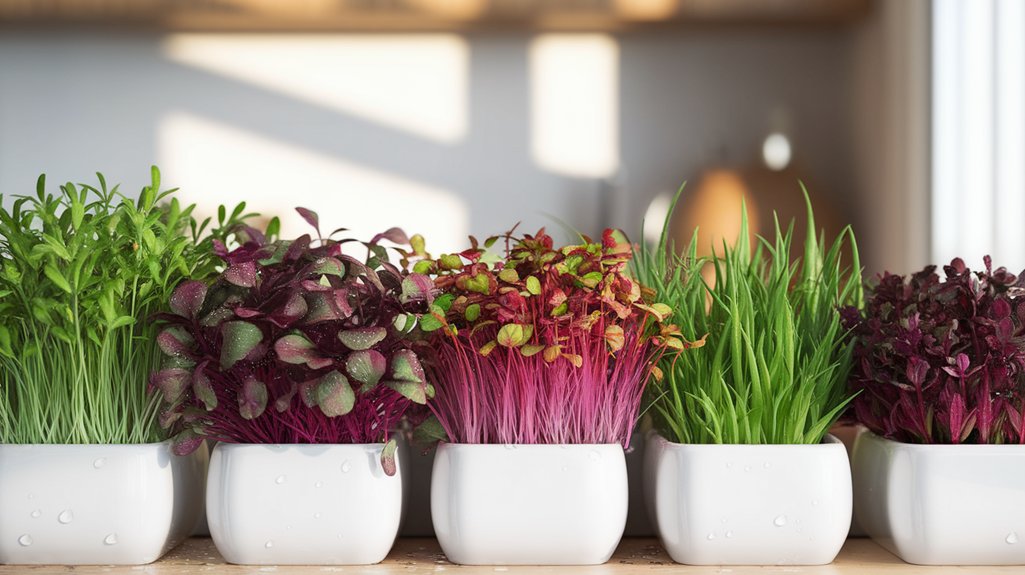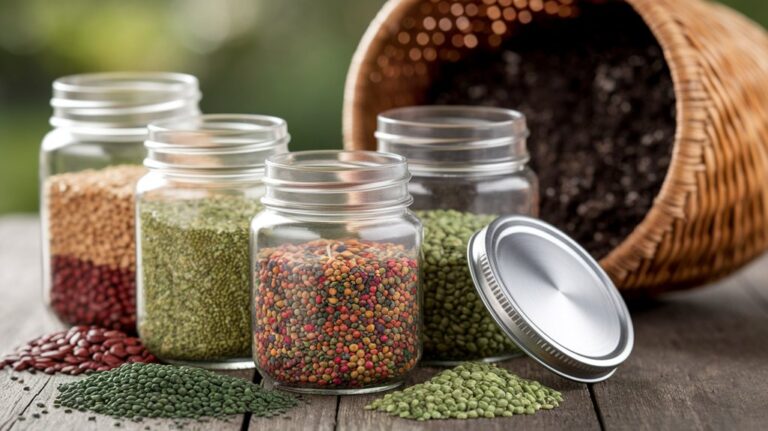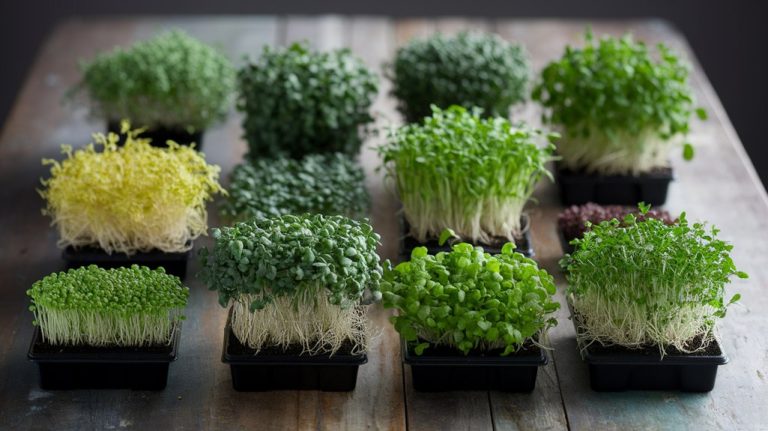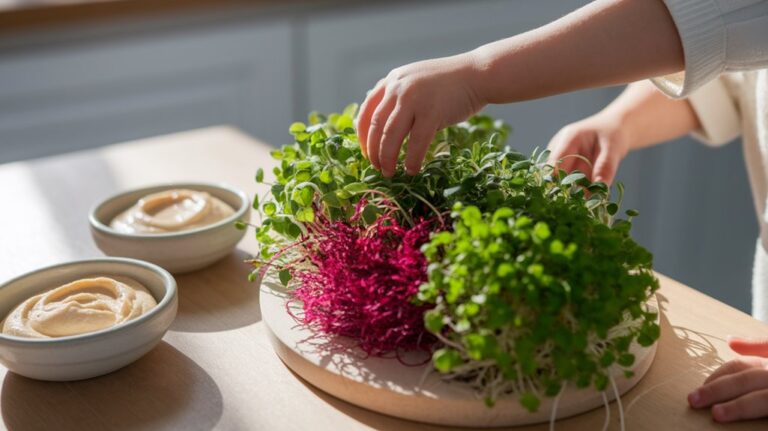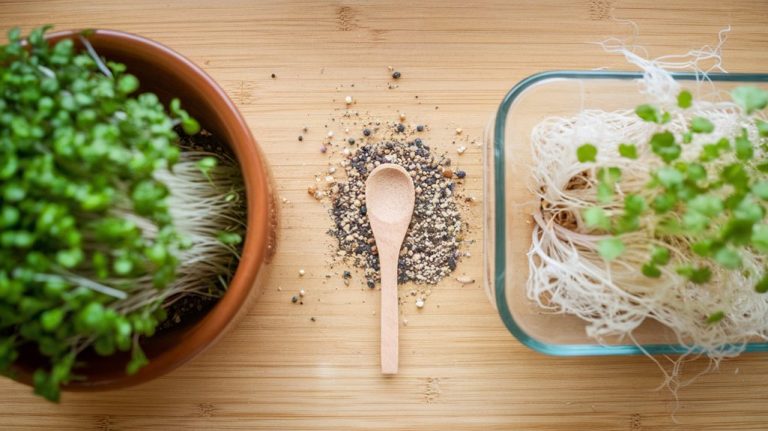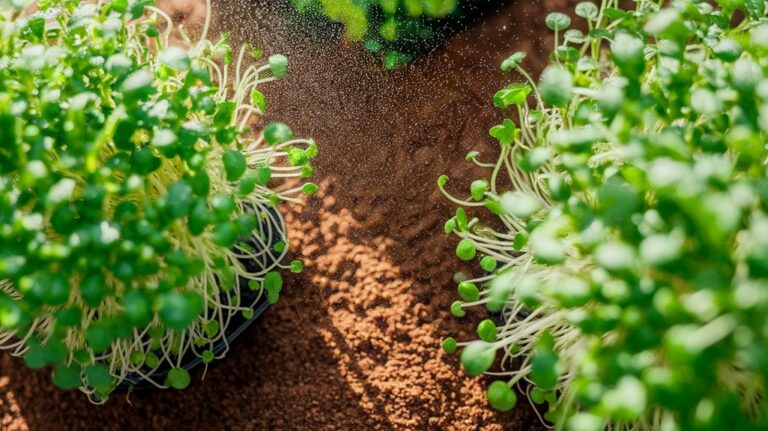10 Surprising Health Benefits of Growing Microgreens at Home
Growing microgreens at home offers impressive health benefits. They’re packed with essential nutrients like vitamins A, C, and K, boosting my immune function and enhancing heart health. These tiny greens also support digestive health and help with weight management by keeping me full. On top of that, their antioxidants protect my skin and reduce inflammation. Plus, cultivating them promotes sustainable practices that make a positive impact. There are even more benefits to discover here!
Key Takeaways
- Growing microgreens at home provides a nutrient-dense food source, often containing up to 40 times more nutrients than mature plants.
- They boost immune function with high levels of vitamins A, C, and E, helping to combat oxidative stress and inflammation.
- Homegrown microgreens support digestive health and weight management due to their fiber content and nutrient density, promoting satiety.
- Cultivating microgreens contributes to heart health by providing antioxidants and omega-3 fatty acids that reduce inflammation and support cardiovascular function.
- The process of growing microgreens can enhance mental well-being, offering a therapeutic activity that positively affects mood and encourages sustainable living practices.
Packed With Essential Nutrients
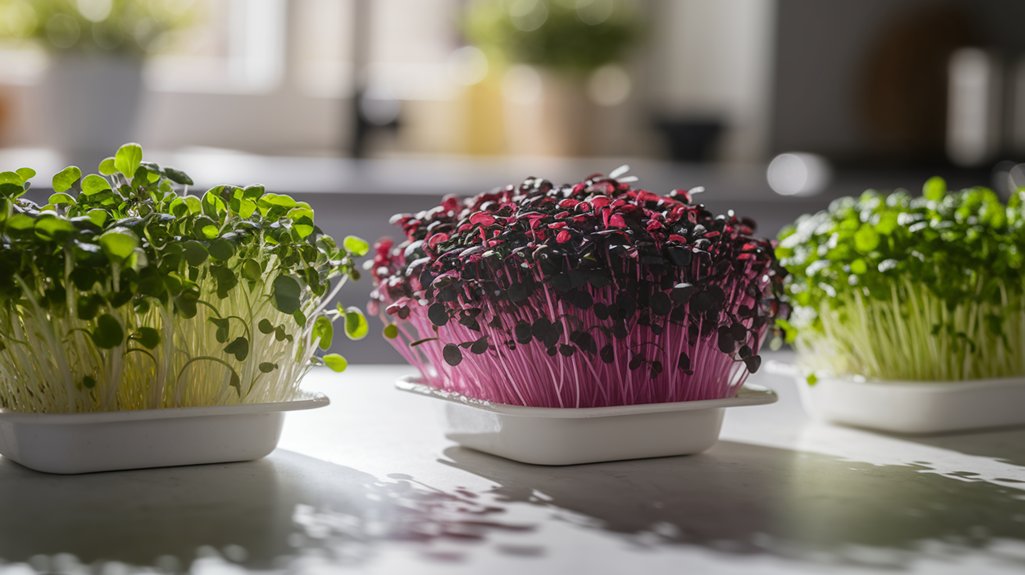
Microgreens are nutritional powerhouses that can elevate your diet with their concentrated vitamins and minerals. I’ve found that just a small serving of these tiny greens can pack a serious punch.
For instance, varieties like broccoli and kale are rich in vitamins A, C, and K, which support overall health. Their antioxidant content is impressive too, helping to combat oxidative stress in the body.
I love adding them to salads, sandwiches, or smoothies for an instant nutrient boost. Plus, they’re incredibly easy to grow at home, making it simple to incorporate fresh nutrition into my meals.
Boosting Immune Function
When I incorporate microgreens into my meals, I often find that they can significantly support immune function.
These tiny greens are nutrient-dense and packed with antioxidants, which play a vital role in strengthening our immune system.
Here are a few benefits I’ve noticed:
- Rich in Vitamins: Microgreens are abundant in vitamins A, C, and E, which are known to boost immune response.
- Antioxidant Properties: They contain high levels of antioxidants, helping to combat oxidative stress in the body.
- Phytonutrients: Many microgreens, like broccoli and kale, are rich in phytonutrients that can enhance immune activity.
Supporting Digestive Health

When I think about supporting digestive health, the nutrient density of microgreens really stands out to me.
They’re packed with vitamins and minerals that can aid digestion, and certain varieties are rich in enzymes that help break down food more effectively.
Incorporating these tiny greens into my meals has made a noticeable difference in how my digestive system feels.
Nutrient Density Benefits
Nutrient-dense microgreens offer a powerhouse of benefits that can significantly support digestive health. When I started incorporating these tiny greens into my meals, I noticed improvements in my overall well-being.
Here are some key reasons why they’re so beneficial for digestion:
- Rich in Fiber: Microgreens contain high fiber levels, which aid in regular bowel movements and a healthy gut.
- Vitamins and Minerals: They’re packed with essential vitamins like A, C, and K, which contribute to a balanced diet and optimal gut function.
- Antioxidant Properties: These greens are loaded with antioxidants that help reduce inflammation, promoting a healthier digestive tract.
Adding nutrient-dense microgreens to my diet has truly made a difference, and I encourage you to give them a try!
Enzyme-Rich Microgreen Varieties
While many microgreens boast impressive nutrient profiles, certain varieties stand out for their enzyme content, making them particularly beneficial for digestive health.
For instance, broccoli microgreens are rich in sulforaphane, an enzyme that supports gut health by aiding digestion and reducing inflammation. Similarly, pea shoots contain protease, which helps break down proteins, enhancing nutrient absorption.
I’ve also discovered that radish microgreens offer enzymes like amylase, promoting carbohydrate digestion. Incorporating these enzyme-rich microgreens into my meals not only adds flavor but also supports my digestive system.
Whether I toss them in salads or blend them into smoothies, I’m confident that these varieties contribute positively to my overall health. Growing them at home makes it easy to enjoy these benefits daily.
Enhancing Heart Health
When it comes to heart health, the nutrient density of microgreens really stands out.
Packed with vitamins and minerals, these tiny greens can contribute to better cardiovascular function.
Plus, their antioxidant properties help combat oxidative stress, which is crucial for maintaining a healthy heart.
Nutrient Density Impact
Microgreens pack a powerful punch in the realm of heart health. These tiny greens aren’t only delicious but also incredibly nutrient-dense, which can significantly benefit your cardiovascular system.
When I started incorporating them into my diet, I noticed some impressive advantages:
- High in vitamins: Microgreens are loaded with essential vitamins like C, E, and K, which support healthy blood vessels.
- Omega-3 fatty acids: Some varieties, like radish greens, contain omega-3s that promote heart health by reducing inflammation.
- Low in calories: These greens allow you to add nutrients without the extra calories, making it easier to maintain a healthy weight.
Antioxidant Properties Benefits
Incorporating microgreens into my diet hasn’t only boosted my nutrient intake but also provided significant antioxidant benefits that further enhance heart health.
Research shows that microgreens, particularly varieties like broccoli and kale, are packed with antioxidants such as vitamins C and E. These compounds fight oxidative stress, which can damage blood vessels and lead to heart disease.
By consuming microgreens regularly, I’m reducing inflammation and supporting healthy blood pressure levels. They’re easy to grow at home, giving me access to fresh, nutrient-rich greens.
Plus, their vibrant flavors and colors make my meals more exciting. With these powerful little plants, I’m taking proactive steps to protect my heart while enjoying delicious, nutritious food.
Promoting Healthy Skin
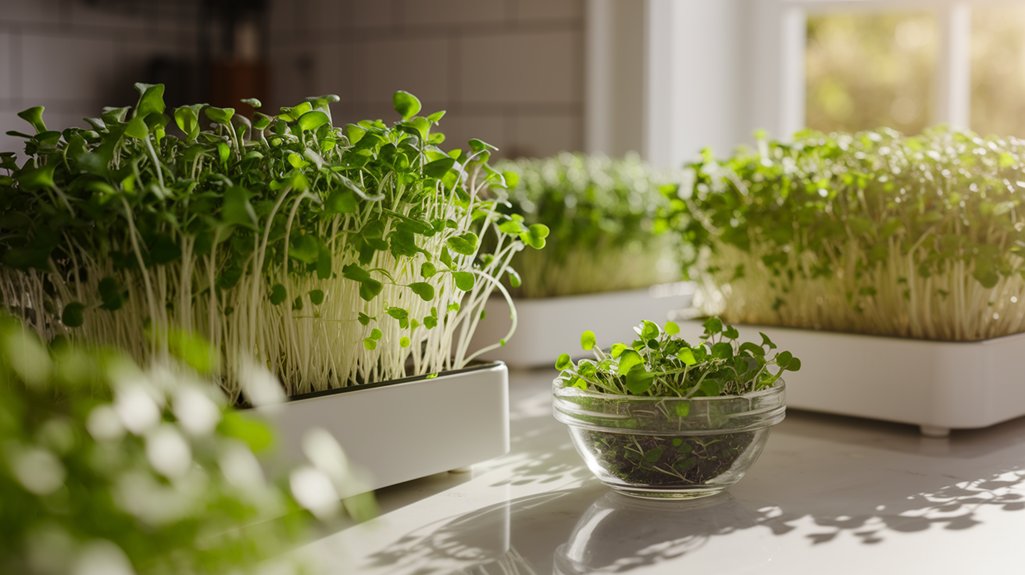
While many people focus on diet and exercise for overall health, the impact of certain foods on skin health often goes overlooked.
I’ve found that growing microgreens can be a game-changer for my skin. These tiny powerhouses are packed with nutrients that can enhance skin health in several ways:
- Rich in Vitamins: Microgreens, especially varieties like kale and radish, are loaded with vitamins A, C, and E, which nourish the skin.
- Hydration Boost: Their high water content helps keep the skin hydrated and plump.
- Antioxidant Protection: The antioxidants found in microgreens combat free radicals, reducing signs of aging.
Incorporating these green wonders into my diet has noticeably improved my skin’s texture and glow.
Give it a try!
Improving Mental Well-being
As I’ve discovered, the positive effects of microgreens on mental well-being are profound and often underestimated. Research indicates that these tiny powerhouses are rich in vitamins and antioxidants, which play a crucial role in brain health. Nutrients such as vitamins C and E can combat oxidative stress, a factor linked to anxiety and depression.
When I grow microgreens, I find the act itself therapeutic; nurturing life, even in small forms, fosters a sense of accomplishment and connection to nature. Furthermore, the vibrant colors and fresh flavors can elevate my mood, creating a more inviting atmosphere at home.
Incorporating microgreens into my diet not only enhances my meals but also positively influences my overall mental state, making it a rewarding practice.
Reducing Inflammation
I’ve found that microgreens are packed with antioxidant-rich nutrients that can play a significant role in reducing inflammation.
These tiny greens not only support our immune system but also help combat oxidative stress in the body.
Incorporating them into my diet has made a noticeable difference in how I feel overall.
Antioxidant-Rich Nutrients
Microgreens pack a powerful punch when it comes to antioxidant-rich nutrients that help reduce inflammation.
I’ve found that incorporating these tiny greens into my diet not only adds flavor but also delivers impressive health benefits.
Here are some key reasons to grow microgreens at home:
- High in Vitamins: Microgreens often contain higher concentrations of vitamins A, C, and E compared to mature plants, which are essential for combating oxidative stress.
- Rich in Phytochemicals: These compounds, such as flavonoids and carotenoids, help neutralize free radicals that can lead to inflammation.
- Easy to Grow: You can cultivate them in small spaces, making it simple to add these nutrient powerhouses to your meals.
Immune System Support
While many foods can bolster our immune system, few do it as effectively as microgreens, which play a crucial role in reducing inflammation.
I’ve found that these tiny greens are packed with vitamins A, C, E, and K, all known to support immune function. Research shows that compounds in microgreens can lower inflammatory markers in our bodies, helping to combat chronic diseases.
For instance, studies indicate that the antioxidants found in varieties like broccoli and radish microgreens can significantly reduce oxidative stress.
Aiding in Weight Management
As you explore healthier eating options, you might find that incorporating microgreens into your diet can significantly aid in weight management.
These tiny greens are nutrient-dense and low in calories, making them a perfect addition to meals without adding extra pounds. Here’s why I love them:
- High Nutrient Content: Microgreens are packed with vitamins and minerals that nourish your body, helping you feel full and satisfied.
- Low in Calories: You can add volume and flavor to your dishes without the guilt of high-calorie ingredients.
- Versatile Usage: Whether in salads, smoothies, or as garnishes, microgreens can enhance any meal, making healthy eating enjoyable.
Incorporating microgreens can be a game-changer in your weight management journey.
Providing Antioxidant Protection
In addition to supporting weight management, microgreens offer impressive antioxidant protection that can benefit overall health.
I’ve discovered that these tiny greens are packed with vitamins C and E, along with various phytochemicals that combat oxidative stress in our bodies. Research shows that microgreens can contain up to 40 times more nutrients than their mature counterparts.
This means incorporating them into my meals not only boosts flavor but also enhances my body’s ability to fight free radicals, which are linked to chronic diseases. I love adding them to salads, smoothies, and sandwiches, knowing I’m providing my body with powerful antioxidants.
Encouraging Sustainable Practices
Growing microgreens not only enhances my meals but also encourages sustainable practices that benefit the environment. When I cultivate these tiny greens, I contribute to a more sustainable lifestyle in several ways:
- Reduced Carbon Footprint: Growing my own microgreens cuts down on transportation emissions associated with store-bought greens.
- Minimal Water Usage: Microgreens require significantly less water than traditional crops, making them an eco-friendly choice.
- Pesticide-Free: By growing them at home, I avoid harmful pesticides, promoting healthier soil and air quality.
These practices not only help the planet but also inspire others to consider their food sources.
It’s rewarding to know that my small garden can have a positive ripple effect on the environment.
Frequently Asked Questions
How Long Does It Take to Grow Microgreens at Home?
Growing microgreens at home usually takes about 7 to 21 days, depending on the variety you choose.
I’ve found that some, like radish or mustard greens, sprout quickly, while others, like basil, can take a bit longer.
It’s fascinating to watch them grow, and I enjoy experimenting with different types.
Just ensure they get enough light and moisture, and you’ll be harvesting fresh greens in no time!
What Types of Microgreens Are Easiest for Beginners?
When I started growing microgreens, I found that some varieties were easier for beginners.
Pea shoots, radish greens, and sunflower microgreens are great choices. They germinate quickly and require minimal care, making them perfect for newcomers.
I loved watching them sprout within days, and their flavors added freshness to my meals.
If you’re just starting, these varieties will boost your confidence and give you a rewarding experience in no time!
Can I Grow Microgreens Indoors Year-Round?
Absolutely, you can grow microgreens indoors year-round!
I’ve found that they thrive in controlled environments, making them perfect for indoor gardening. Just make sure you provide adequate light, either from natural sunlight or grow lights, and keep the temperature consistent.
I’ve had great success with varieties like radish and pea shoots, which sprout quickly. With a little attention, you’ll enjoy fresh greens no matter the season!
Do Microgreens Require Special Lighting to Thrive?
Yes, microgreens do require special lighting to thrive, especially if you’re growing them indoors.
I’ve found that using grow lights can significantly enhance their growth. Natural sunlight is great, but often insufficient, especially in winter months.
I typically keep my lights on for about 12-16 hours daily to mimic their natural environment. This consistent exposure helps ensure vibrant colors and robust flavors in my microgreens, making the effort well worth it!
How Do I Store Harvested Microgreens for Freshness?
To store harvested microgreens for freshness, I place them in a clean, dry container lined with a damp paper towel.
I make sure to seal the container tightly to keep moisture in without causing excess humidity.
Storing them in the fridge helps maintain their crispness.
It’s best to consume them within a week for optimal flavor and nutrition.
I’ve found this method keeps my microgreens vibrant and delicious!
Conclusion
In conclusion, growing microgreens at home offers a wealth of health benefits that can significantly enhance your well-being. From packing essential nutrients to providing antioxidant protection, these tiny greens can transform your diet and lifestyle. Plus, they’re easy to grow and encourage sustainable practices. So why not give it a try? You’ll not only enjoy the fresh flavors they bring to your meals but also reap the numerous health advantages they offer. Happy gardening!

